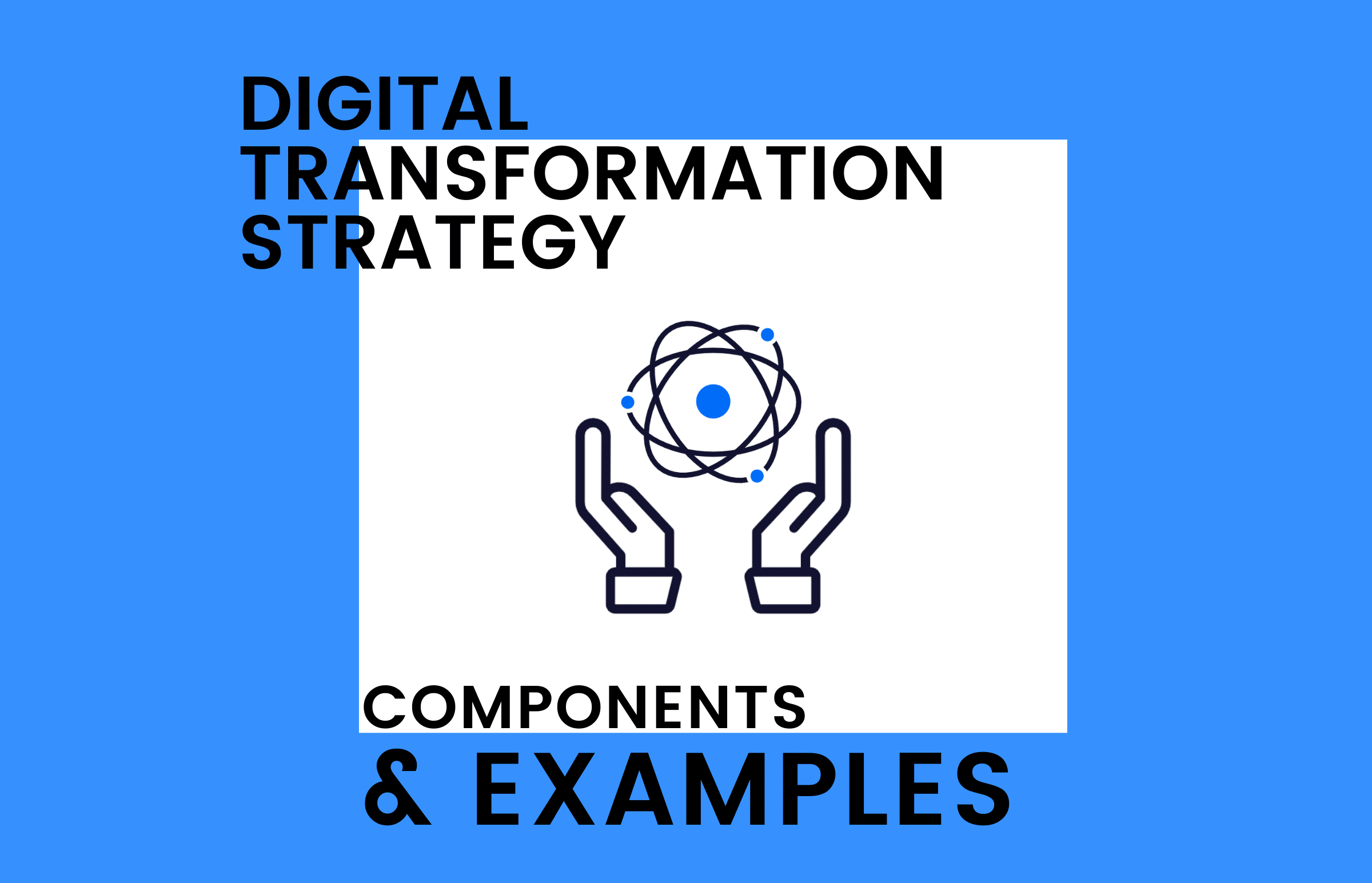According to data by Google, 98% of consumers worldwide browse, research, and purchase things on the Internet. In 2020 alone, over two billion people bought goods or services online, and global e-commerce sales are expected to surpass $6.5 trillion in 2023.
Market pressure and growth opportunities fuel 40% of digital transformation efforts. 89% of all companies have already adopted or plan to adopt a digital-first business strategy. 76% of businesses plan on long-term IT changes as a result of COVID-19. 91% of businesses are engaged in some form of digital initiative. 40% of organisations have brought digital initiatives to scale.
Numbers like these mean one thing: As consumers become more tech-savvy by the day, businesses that don’t have a solid online presence risk fading into irrelevance.
Components of a Digital Transformation Strategy
- Vision: A clear vision of what you want to achieve with digital transformation.
- Goals: Specific, measurable, achievable, relevant, and time-bound roadmap goals.
- Strategy: A plan for how you will achieve your goals.
- Metrics: Metrics to track your progress and measure the success of your digital transformation efforts.
- Culture: A culture that is supportive of innovation and experimentation.
What Is a Digital Transformation Strategy?
A digital transformation strategy is a long-term, step-by-step plan for changing business models to make them more competitive in an increasingly digital economy.
This can include any of the following:
- Digitising and/or automating previously manual tasks
- Using technology to detect and remove bottlenecks, streamline processes, and realise cost savings
- Swapping legacy systems for more modern solutions
- Adopting emerging technology
- Making products and services available online
- Leveraging digital marketing to reach more customers
- Continually improving the digital user experience
In practical terms, your digital transformation strategy may involve anything from revamping your website and building a mobile app to better connect with customers to creating dedicated e-commerce and digital marketing strategies, infusing your products and services with more digital value, upgrading internal software systems, and much more. Additionally, integrating white label marketing services can enhance your offerings without the need for extensive in-house resources.
The exact components of your digital transformation strategy will be unique to the nature of your service offering, your specific business objectives, and your customers’ needs.
Examples of Digital Transformation Success
1- Amazon:
Amazon’s transition from an online bookstore to a global e-commerce giant is a prime digital transformation example in retail. Amazon’s global e-commerce sales were $469.8 billion in 2021. Amazon’s digital transformation success is due to a number of factors, including:
- Customer Obsession
Amazon is laser-focused on customer satisfaction. The company uses data analytics to understand its customers’ needs and preferences, and then it designs its products and services accordingly.
- Innovation
Amazon is constantly innovating and experimenting with new technologies. For example, the company was one of the first to adopt cloud computing and big data analytics.
- Agility
Amazon is able to quickly adapt to changing market conditions. The company has a decentralised organisational structure that allows it to move quickly and make decisions without having to go through a lot of bureaucracy.
2- Netflix:
The company disrupted the entertainment industry by shifting from DVDs to an online streaming platform.” – Netflix had 220.67 million subscribers worldwide in 2022. Netflix’s digital transformation success is also due to a number of factors, including:
- Content-First Strategy
Netflix invests heavily in original content, which has helped it to differentiate itself from its competitors.
- Data-Driven Decision-Making
Netflix uses data analytics to make decisions about everything from what content to produce to how to price its subscriptions.
- Global Expansion
Netflix has rapidly expanded into new markets around the world. This has helped the company to grow its subscriber base and increase its revenue.
3- Starbucks:
Starbucks improved the customer experience and boosted sales through its mobile app and loyalty program. Starbucks’ mobile app accounted for 28% of all U.S. orders in 2021. Starbucks’ digital transformation success is due to a number of factors, including:
- Starbucks App
The Starbucks app allows customers to order and pay for drinks in advance, which saves them time and makes the ordering process more convenient.
- Loyalty and Reward Program
Starbucks’ loyalty program rewards customers for their purchases. This program has helped to increase customer engagement and retention.
- Omnichannel Experience
Starbucks offers customers a variety of ways to purchase their drinks, including in-store, online, and through the mobile app. This omnichannel experience gives customers more flexibility and convenience.
4- Nike
Nike’s e-commerce sales grew 19% in fiscal year 2023, reaching $20.5 billion. This growth was driven by a number of factors, including:
- Strong Demand for Nike Products
Nike products are in high demand among consumers, both online and offline. The company’s strong brand and reputation help to drive sales.
- Investments in e-Commerce
Nike has invested heavily in its e-commerce platform in recent years. The company has made it easier for customers to shop online and has improved its delivery options.
- Growth in Key Markets
Nike’s e-commerce sales are growing rapidly in key markets such as China and North America. These markets are home to a large number of potential customers, and Nike is well-positioned to capitalise on this growth.
5- Walmart
Walmart’s e-commerce sales grew 9% in the first quarter of fiscal year 2024, reaching $23.6 billion. This growth was driven by a number of factors, including:
- Strong Grocery Sales
Walmart’s grocery sales online are growing rapidly. The company is offering more convenient and affordable ways for customers to order and pick up groceries.
- Growth in Omnichannel Sales
Walmart’s omnichannel sales, including online orders picked up in stores, are also growing rapidly. This is because customers appreciate the convenience of ordering online and picking up their purchases in-store.
- Expansion into New Markets
Walmart is expanding its e-commerce presence into new markets, such as India and Mexico. These markets boast a substantial pool of potential customers, and Walmart is ideally positioned to seize the opportunities presented by this expansion.
Digital Strategy vs. Digital Transformation Strategy
The terms “digital strategy” and “digital transformation strategy” are sometimes used interchangeably, but it’s essential to recognise that they represent distinct, albeit interconnected, concepts.
- a) Digital Strategy
A digital strategy primarily focuses on harnessing digital technologies to enhance specific business processes. These processes can encompass a wide array of areas, including operations, marketing, customer service, finance, or HR, as well as catering to various stakeholders, such as employees, customers, or suppliers.
- b) Digital Transformation Strategy
In contrast, digital transformation strategies are ambitious, large-scale initiatives. They aim to construct entirely new business models by harnessing a blend of crucial elements:
- Digital Technologies: This encompasses cutting-edge technologies like artificial intelligence (AI), machine learning, predictive analytics, and cloud computing.
- Digital Tools: These tools encompass a diverse range, including robotics, sensors, mobile apps, and digital communication platforms.
- Best and Emerging Practices: This entails the integration of practices like continuous improvement, continuous innovation, DevOps and Site Reliability Engineering, lean methodologies, and business process management (BPM).
The core goal of a digital transformation strategy is to revolutionise your business model for competitiveness in the digital economy. This spans across departments and processes, making it the powerful version of digital strategies.
This approach ensures your business embraces digital technologies and evolves successfully in the rapidly changing digital landscape.
Why Is Digital Transformation Important?
According to a recent study by Deloitte, 83% of CEOs believe that digital transformation is essential to their company’s future success.
Digital transformation is important because it can help businesses to:
- Improve customer satisfaction and loyalty: By using digital technology and innovative business models, you can better cater to customer needs.
- Increase sales and profitability: Leveraging digital strategies can open new revenue streams and expand your market.
- Reduce costs and improve efficiency: Streamlining business processes and adopting digital solutions often lead to cost savings.
- Gain a competitive advantage: Staying up-to-date with digital technologies helps you outperform competitors.
How to Develop a Digital Transformation Strategy in 6 Steps
Creating a digital transformation strategy takes time and concentrated effort, but if done right, the results will be well worth it.
While all businesses are different, and no two strategies are 100% alike, most digital transformation strategies will involve the following steps:
1. Decide Want You to Achieve With Digital Transformation
According to a study by McKinsey, 60% of digital transformation initiatives fail because they lack a clear vision and strategy.
Once you know why the digital transformation process is important, you need to define what you want to achieve. This could include:
- Improving the customer experience: Use digital solutions to enhance customer service, streamline the customer journey, and meet customer expectations.
- Launching new products and services: Digital transformation can lead to the creation of new digital products and services.
- Expanding into new markets: Digital technology can help you reach a global audience.
- Increasing operational efficiency: Automation tools such as sales automation software and many other digital tools can streamline your business processes.
- Reducing costs: Cutting costs through digitalisation can free up resources for other initiatives.
2. Achieve an Enterprise-Wide Mindset Shift
Digital transformation is not just an IT project. It requires a change in mindset across the entire organisation. Employees need to be open to new ways of working and new technologies. According to a study by IBM, only 30% of businesses have a culture that is supportive of digital transformation.
How to Encourage an Enterprise-Wide Mindset Shift
- Communicate the vision for digital transformation to all employees. Ensure everyone understands the purpose and benefits.
- Involve employees in the planning and implementation of digital transformation initiatives. Engage your workforce in the transformation process.
- Provide training and support to employees on new technologies and ways of working. Ensure your staff is equipped with the necessary skills.
- Create a culture of innovation and experimentation. Encourage employees to explore digital innovations.
3. Set the Right Collaborations with Partners and Experts
No business can go through digital transformation alone. It is important to collaborate with partners and experts who can provide the necessary support and expertise. If you’re struggling with defining your needs at this stage, consider our digital transformation strategy consulting services.
According to a study by Forrester, 70% of businesses are collaborating with partners on their digital transformation initiatives.
How to Collaborate With Partners and Experts
- Identify partners who have the necessary skills and experience to help you achieve your digital transformation goals. Choose partners wisely.
- Develop clear agreements with your partners that outline their roles and responsibilities. Ensure everyone is on the same page.
- Work closely with your partners to ensure that your digital transformation initiatives are successful. Maintain open communication and cooperation.
One such example for businesses who need to also expand their digital services is leveraging an SEO reseller program, which allows agencies and businesses to offer professional SEO services under their own brand, backed by the expertise of a dedicated team.
4. Share and Educate
According to a study by Gartner, only 40% of businesses have a communication plan in place for their digital transformation initiatives.
Communicating your digital transformation initiatives to all stakeholders, including employees, customers, partners, and investors, is important. This will help to ensure that everyone is aligned with the vision and strategy for digital transformation.
How to Share and Educate Stakeholders
- Develop a communication plan that outlines your goals and objectives for digital transformation. Clearly communicate your strategy.
- Use a variety of communication channels to reach your stakeholders. Utilise digital marketing campaigns, internal communications, and more.
- Be transparent and honest about the challenges and opportunities of digital transformation. Address concerns and expectations.
- Answer questions and feedback from stakeholders. Engage with your audience.
5. Continually Adjust Your Processes
The digital landscape is constantly changing, so it is important to continually adjust your digital transformation strategy accordingly. This will help you to stay ahead of the curve and remain competitive.
According to a study by PwC, 75% of businesses say that their digital transformation strategies are not set in stone.
How to Continually Adjust Your Processes
- Monitor the digital landscape and identify new trends and technologies. Stay informed about industry standard practices.
- Assess the impact of new trends and technologies on your business. Evaluate how these can benefit your business.
- Make adjustments to your digital transformation strategy as needed. Be agile in adapting to new technologies and customer demands.
By following these six steps, you can develop a digital transformation strategy that will help you achieve your business goals and objectives in the digital economy.
Key Takeaway
Digital transformation is a complex but necessary process for modern businesses. It involves integrating digital technology, re-engineering business processes, customer-centricity, and strong leadership. Learning from successful examples can provide valuable insights into achieving digital transformation objectives and remaining competitive in today’s digital economy.
Remember, a well-crafted digital transformation strategy tailored to your specific business goals is the cornerstone of this digital transformation journey toward digital excellence.
Unlocking Digital Transformation Success with Zartis
Your competitors are going digital, and you don’t want to get left behind. Sure, digital transformation can be daunting, but the good news is you don’t have to go it alone.
Zartis stands as a beacon of expertise in helping businesses embark on their digital transformation journey. Our team has a proven track record of integrating cutting-edge digital technologies, redefining business models, and driving organisational change.
Explore our case studies for real-world examples! With our assistance, you can unlock the full potential of digital transformation, just as we’ve done for numerous clients. With our scaling and modernisation services, you can bring radical new ideas to life and get your business ready for the digital age.
Contact us to kickstart your digital transformation! Let’s embark on a transformational journey together! Your digital future begins here with Zartis.


